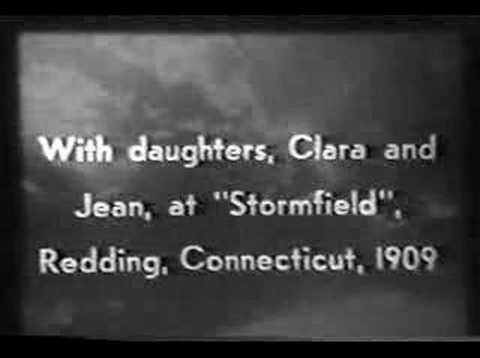The father of American literature, Mark Twain was also known by his fondness in science and scientific inquiry. He developed a close and lasting friendship with Nikola Tesla, and the two spent much time together in Tesla’s laboratory.
In 1909, Thomas Edison visited MarkTwain at his home in Redding, Connecticut and filmed him. Part of the footage was used in The Prince and the Pauper (1909), a two-reel short film. It is said to have been the only known existing film footage of Twain.

Twain passed through a period of deep depression that began in 1896 when his daughter, Susy, died of meningitis. Olivia’s death in 1904 and Jean’s on December 24, 1909, deepened his gloom. On May 20, 1909, his close friend Henry Rogers died suddenly. In 1906, Twain began his autobiography in the North American Review. In April, Twain heard that his friend Ina Coolbrith had lost nearly all she owned in the 1906 San Francisco earthquake, and he volunteered a few autographed portrait photographs to be sold for her benefit. To further aid Coolbrith, George Wharton James visited Twain in New York and arranged for a new portrait session. Initially resistant, Twain admitted that four of the resulting images were the finest ones ever taken of him.
Twain formed a club in 1906 for girls he viewed as surrogate granddaughters, the Angel Fish and Aquarium Club. The dozen or so members ranged in age from 10 to 16. Twain exchanged letters with his “Angel Fish” girls and invited them to concerts and the theatre and to play games. Twain wrote in 1908 that the club was his “life’s chief delight”.In 1907, Twain met Dorothy Quick (then aged 11) on a transatlantic crossing, beginning “a friendship that was to last until the very day of his death”.
In 1909, Twain said:
I came in with Halley’s Comet in 1835. It is coming again next year, and I expect to go out with it. It will be the greatest disappointment of my life if I don’t go out with Halley’s Comet. The Almighty has said, no doubt: ‘Now here are these two unaccountable freaks; they came in together, they must go out together’.
His prediction was accurate—Twain died of a heart attack on April 21, 1910, in Redding, Connecticut, one day after the comet’s closest approach to Earth.
Upon hearing of Twain’s death, President William Howard Taft said
- “Mark Twain gave pleasure – real intellectual enjoyment – to millions, and his works will continue to give such pleasure to millions yet to come … His humor was American, but he was nearly as much appreciated by Englishmen and people of other countries as by his own countrymen. He has made an enduring part of American literature.”
Twain’s funeral was at the “Old Brick” Presbyterian Church in New York. He is buried in his wife’s family plot at Woodlawn Cemetery in Elmira, New York. The Langdon family plot where he is buried is marked by a 12-foot (two fathoms, or “mark twain”) monument, placed there by his surviving daughter, Clara. There is also a smaller headstone. Although he expressed a preference for cremation (for example in Life on the Mississippi), he acknowledged that his surviving family would have the last word.
Officials in Connecticut and New York estimated the value of Twain’s estate at $471,000 ($12,000,000 today)
